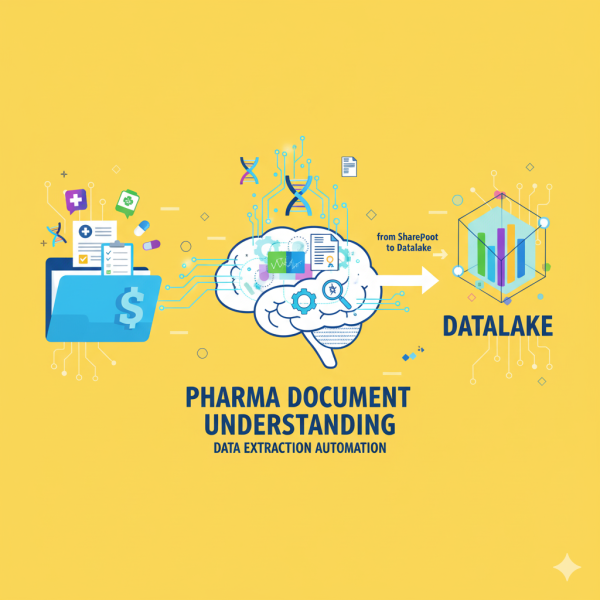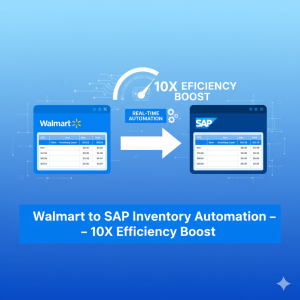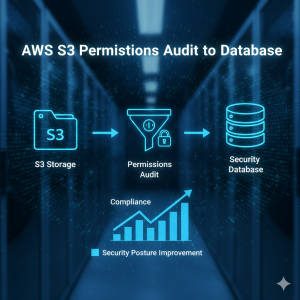Pharma Document Understanding- Data Extraction Automation
$0.00
| Workflow Name: |
Pharma Document Understanding using AI |
|---|---|
| Purpose: |
Automate extraction and processing of unstructured pharma documents |
| Benefit: |
Accelerates document handling; improves accuracy; reduces manual effort |
| Who Uses It: |
Pharma analysts; QA teams; Regulatory staff; Data engineering teams |
| System Type: |
Document Automation; AI Workflow |
| On-Premise Supported: |
Yes |
| Supported Protocols: |
HTTPS / REST |
| Industry: |
Pharmaceuticals |
| Outcome: |
Faster processing; improved data accessibility |
Table of Contents
Description
| Problem Before: |
Manual extraction from SharePoint was slow; error-prone; and inconsistent |
|---|---|
| Solution Overview: |
AI extracts; classifies; and validates key pharma document data and pushes it to the Data Lake |
| Key Features: |
OCR; NLP extraction; field classification; SharePoint connector; Data Lake integration |
| Business Impact: |
70% faster document processing; 90% reduction in errors |
| Productivity Gain: |
3x more documents processed per analyst |
| Cost Savings: |
Reduces operational cost by 40% |
| Security & Compliance: |
Pharma-grade compliance; audit logging |
Pharma Document Understanding
Streamline Pharma Document Understanding by automating the extraction, structuring, and validation of critical data from documents. This no-code workflow ensures faster, more accurate processing of pharma files, reducing manual effort and compliance risks.
Intelligent Data Mapping & Validation
With automated data mapping, the system identifies and extracts key fields such as product details, batch data, specifications, and compliance attributes. It validates, standardizes, and organizes the information for downstream systems, enabling higher accuracy, faster reviews, and improved regulatory readiness.
Watch Demo
| Video Title: |
Pharma Industry Document Automation: Use Cases, Data Flow |AI Document Understanding |
|---|---|
| Duration: |
07:30 |
Outcome & Benefits
| Time Savings: |
70% faster document handling |
|---|---|
| Cost Reduction: |
40% cost reduction |
| Accuracy: |
90%+ accuracy |
| Productivity: |
3x more documents per analyst |
Industry & Function
| Function: |
Document Processing; Workflow Automation |
|---|---|
| System Type: |
Document Automation; AI Workflow |
| Industry: |
Pharmaceuticals |
Functional Details
| Use Case Type: |
Pharma Document Automation |
|---|---|
| Source Object: |
Unstructured pharmaceutical documents |
| Target Object: |
Data Lake structured records |
| Scheduling: |
Hourly or on-demand |
| Primary Users: |
Pharma QA analysts; regulatory teams; data consumers |
| KPI Improved: |
Processing time; error reduction; workforce productivity |
| AI/ML Step: |
OCR + NLP document understanding |
| Scalability Tier: |
Enterprise-grade; scalable ingestion |
Technical Details
| Source Type: |
SharePoint |
|---|---|
| Source Name: |
Pharma SharePoint Repository |
| API Endpoint URL: |
/api/v1/pharma-doc-ai |
| HTTP Method: |
POST / GET |
| Auth Type: |
OAuth 2.0 |
| Rate Limit: |
1000 requests/min |
| Pagination: |
Page-based |
| Schema/Objects: |
Document metadata; extracted content; annotations |
| Transformation Ops: |
Text extraction; NLP classification; data normalization |
| Error Handling: |
Retry logic; event logging; exception queue |
| Orchestration Trigger: |
Scheduled or event-based |
| Batch Size: |
100 documents per batch |
| Parallelism: |
5 threads |
| Target Type: |
Data Lake |
| Target Name: |
Enterprise Data Lake |
| Target Method: |
POST / PUT |
| Ack Handling: |
Data Lake confirms ingestion |
| Throughput: |
1000 docs/hour |
| Latency: |
<2 minutes per document |
| Logging/Monitoring: |
Cloud logs and monitoring dashboard |
Connectivity & Deployment
| On-Premise Supported: |
Yes |
|---|---|
| Supported Protocols: |
HTTPS / REST |
| Cloud Support: |
AWS; Azure; Private Cloud |
| Security & Compliance: |
Pharma-grade compliance; audit logging |
FAQ
1. What is Pharma Document Understanding?
Pharma Document Understanding refers to the automated extraction, classification, and validation of data from pharmaceutical documents to streamline processing and reduce manual tasks.
2. How does automated document data extraction work?
The system uses OCR, AI models, and data mapping to identify key fields, extract structured information, and validate accuracy before sending data to downstream systems.
3. What types of pharma documents can be processed?
It supports SOPs, COAs, batch records, product specs, regulatory documents, quality reports, and other pharma-related files.
4. How is data accuracy ensured during extraction?
AI-driven validation checks, rule-based verification, and automated formatting ensure high accuracy and compliance with pharma documentation standards.
5. Can the workflow integrate with other pharma systems?
Yes. The extracted data can be pushed to LIMS, QMS, ERP systems, or custom pharma applications for faster decision-making and seamless data flow.
6. What are the benefits of automating pharma document extraction?
Automation reduces manual workload, speeds up reviews, improves data accuracy, ensures compliance readiness, and enhances operational efficiency.
Case Study
| Customer Name: |
Global Pharma Company |
|---|---|
| Problem: |
Slow and manual document extraction from SharePoint |
| Solution: |
AI-based Pharma Document Understanding workflow |
| ROI: |
Faster approvals; redeployment of staff; 3-month payback |
| Industry: |
Pharmaceuticals |
| Outcome: |
Faster processing; improved data accessibility |






